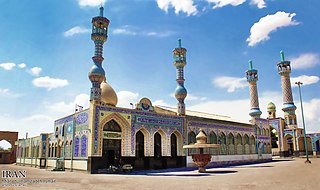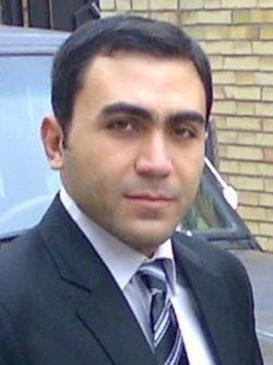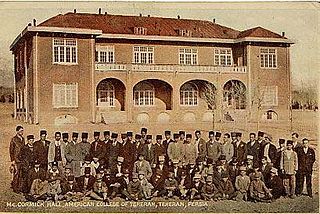This article's use of external links may not follow Wikipedia's policies or guidelines.(January 2017) |
This article's use of external links may not follow Wikipedia's policies or guidelines.(January 2017) |
Stem Cell Research Center, Tabriz University of Medical Sciences, Tabriz, Iran Drug Applied Research Center, Tabriz University of Medical Sciences, Tabriz, Iran

The University of Tehran is the oldest and most prominent Iranian university located in Tehran, Iran. Based on its historical, socio-cultural, and political pedigree, as well as its research and teaching profile, UT has been nicknamed "The Mother University [of Iran]". In international rankings, UT has been ranked as one of the best universities in the Middle East and is among the top universities of the world. It is also the premier knowledge producing institute among all OIC countries. Tehran University of Medical Sciences is in the 7th ranking of the Islamic World University Ranking in 2021. The university offers more than 111 bachelor's degree programs, 177 master's degree programs, and 156 PhD. programs. Many of the departments were absorbed into the University of Tehran from the Dar al-Funun established in 1851 and the Tehran School of Political Sciences established in 1899.

Tabriz is a city in the Central District of Tabriz County, in the East Azerbaijan province of northwestern Iran. It is capital of the province, county, and district. It is the sixth-most-populous city in Iran.

East Azerbaijan Province is one of the 31 provinces of Iran. It is located in Iranian Azerbaijan, bordering Armenia, Republic of Azerbaijan, Ardabil province, West Azerbaijan province, and Zanjan province. The capital of the province is Tabriz. East Azerbaijan province is in Region 3 of Iran, with its secretariat located in its capital city, Tabriz.

The University of Tabriz is a public university located in Tabriz, East Azerbaijan, with the fundamental aim of creating a center of excellence in higher education and research. It is one of the top five high-ranked universities in Iran and one of the ten most selective universities in the country. The University of Tabriz is the second-oldest university in Iran after the University of Tehran, and has the second largest campus area in the country which is the biggest academic institution in northwest of the country. The university is also a member of the Caucasus University Association.

Shahid Beheshti University (SBU), originally founded as the Melli University, is a public research university in Tehran, Iran. The university offers many programs at Bachelor's, Master's and Ph.D. levels.

Iran has a large network of private, public, and state affiliated universities offering degrees in higher education. State-run universities of Iran are under the direct supervision of Iran's Ministry of Science, Research and Technology and Ministry of Health and Medical Education. According to article 3 of the Constitution of the Islamic Republic of Iran, Iran guarantees "free education and physical training for everyone at all levels, and the facilitation and expansion of higher education."

The Isfahan University of Technology (IUT) is a leading public university in Iran, situated near the city of Isfahan. The university comprises 14 faculties and departments, serving approximately 11,000 students and employing 600 academic staff members. IUT offers undergraduate, graduate, and doctoral programs across four main disciplines: engineering, basic sciences, agriculture, and natural resources. Notably, IUT was the first Iranian university to gain membership in CERN.

Tehran University of Medical Sciences (TUMS) is the largest and most highly ranked medical university of Iran. In September 2008, Iran's Minister of Health, Treatment, and Medical Education, Dr. Lankarani, called TUMS a pioneer in research throughout the country with a noticeable lead over its peer universities.

Tabriz University of Medical Sciences (TUOMS) is public medical sciences university located in Tabriz, East Azarbaijan Province, Iran. It is ranked as one of Iran's top medical school, with more than 5000 students.

The Joan & Sanford I. Weill Medical College of Cornell University is Cornell University's biomedical research unit and medical school in New York City.

Sahand University of Technology (SUT) (Persian: دانشگاه صنعتی سهند, Danushgah-e Sân'ti-ye Sihend) Sahand University of Technology (SUT) as the first technical university in Iran after Islamic revolution was established in 1989 in Osku County, SUT located in the north-west hub of industries and endeavors to fulfill the essential needs either for educating high skilled committed engineers, researchers, and scientists for performing research and development projects. SUT offers over 20 BSc programs and more than 100 graduate programs of study in engineering, science and technology, which are consistent with the needs of the region and the country.

Mianeh is a city in the Central District of Mianeh County, East Azerbaijan province, Iran, and serves as capital of both the county and the district. It is the fourth most populous city in East Azerbaijan province.
Abass Alavi is an Iranian-American physician-scientist specializing in the field of molecular imaging, most notably in the imaging modality of positron emission tomography (PET). In August 1976, he was part of the team that performed the first human PET studies of the brain and whole body using the radiotracer [18F]Fluorodeoxyglucose (FDG). Alavi holds the position of Professor of Radiology and Neurology, as well as Director of Research Education in the Department of Radiology at the University of Pennsylvania. Over a career spanning five decades, he has amassed over 2,300 publications and 60,000 citations, earning an h-index of 125 and placing his publication record in the top percentile of scientists.

Ramin Pourandarjani was an Iranian physician who examined prisoners wounded and killed during the 2009 Iranian election protests. Pourandarjani was born on 9 June 1983 to a middle class family in a northwestern district of the city of Tabriz. He died under mysterious circumstances on November 10, 2009, at the age of 26. Tehran's public prosecutor Abbas Dowlatabadi said Ramin Pourandarjani died of poisoning from a delivery salad laced with an overdose of blood pressure medication. The findings fueled opposition fears that he was killed because of what he knew. Pourandarjani had worked as a physician at the Kahrizak detention center. Iranian authorities earlier had claimed at various points that Pourandarjani had been injured in a car accident, committed suicide, or died of a heart attack in his sleep at the health center at the police headquarters in Tehran where he worked.

Iran has made considerable advances in science and technology through education and training, despite international sanctions in almost all aspects of research during the past 30 years. Iran's university population swelled from 100,000 in 1979 to 2 million in 2006. In recent years, the growth in Iran's scientific output is reported to be the fastest in the world.

Azarbaijan Shahid Madani University, commonly called only Azarbaijan University, is a public university located near Tabriz, East Azerbaijan Province, Iran, founded in 1987. The university provides both undergraduate and graduate education to approximately 7,500 students at a wide range of fields including engineering, basic sciences, literature and theology. The university has got Research Gate's total impact point of 1716.47 from 61 publications, according to the latest statistics.
The Islamic Azad University, Tabriz Branch (IAUT) (Persian: دانشگاه آزاد اسلامی واحد تبریز, is biggest and the second oldest branch of Islamic Azad University of Iran in the Tabriz city. The global university ranking of Islamic Azad universities is 394 according to U.S. News and 342 according to CWUR ranking. Tabriz branch is the best in Psychology and Architecture.
Soodabeh Davaran is an Iranian researcher, and professor of polymer chemistry in the Faculty of Pharmacy in Tabriz University of Medical Sciences. She has written many articles about chemistry.

Academic relations between Iran and the United States involve a branch of cultural relations between the two countries that became widespread, especially during the Pahlavi dynasty era.